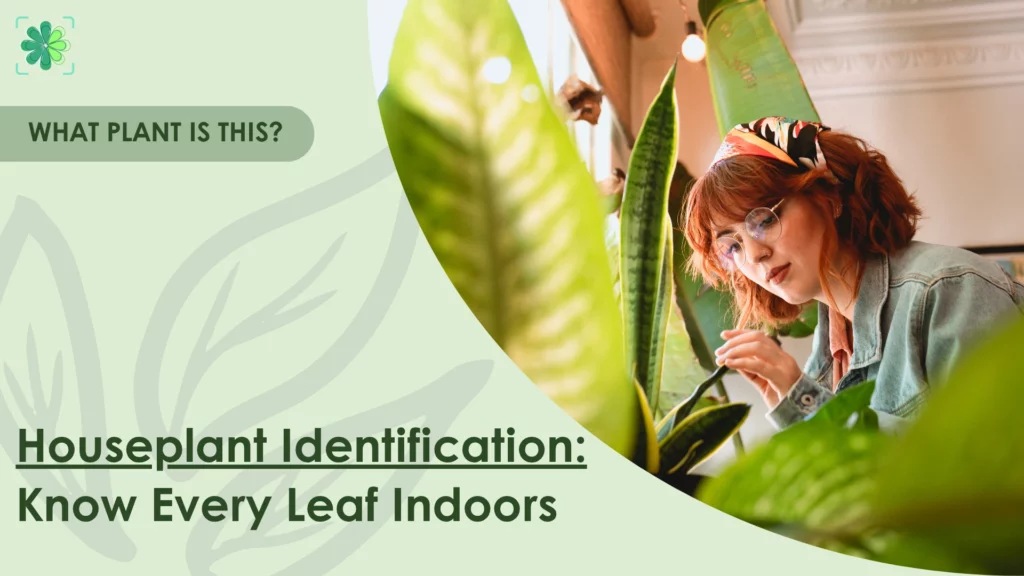
If you’re unsure what kind of plant you have at home, this houseplant identification guide can help. It shows you how to identify common indoor plants by examining their leaves, stems, and growth habits. Knowing your plant’s name makes it easier to care for it and keep it healthy. Let’s start now!
When You Might Need Houseplant Identification?
There are several situations where proper indoor plant ID becomes important, even urgent.
- Bought a plant without a tag? Without a name, it’s hard to know how much water, sunlight, or humidity it needs.
- Inherited or received a plant with no label? You’ll need to identify it to give it the right care.
- Admired a healthy plant in a friend’s apartment or office? Identifying it helps you get the same variety and recreate the right conditions.
- Not sure if a plant is toxic to pets? Some common houseplants can be dangerous to cats or dogs, so ID helps you avoid health risks.
- Seeing signs of pests or unusual leaf damage? You can’t treat the issue correctly unless you know what kind of plant you’re dealing with.
Whether it’s for care, safety, or curiosity, houseplant identification gives you the information you need to grow healthier plants indoors.
Visual Clues to Help You Identify a Houseplant
Successful houseplant identification often begins with observing four key visual traits: leaf structure, texture and color, growth pattern, and stem or root characteristics. Each offers valuable insight when trying to recognize common indoor plants.
Leaf Shape and Size
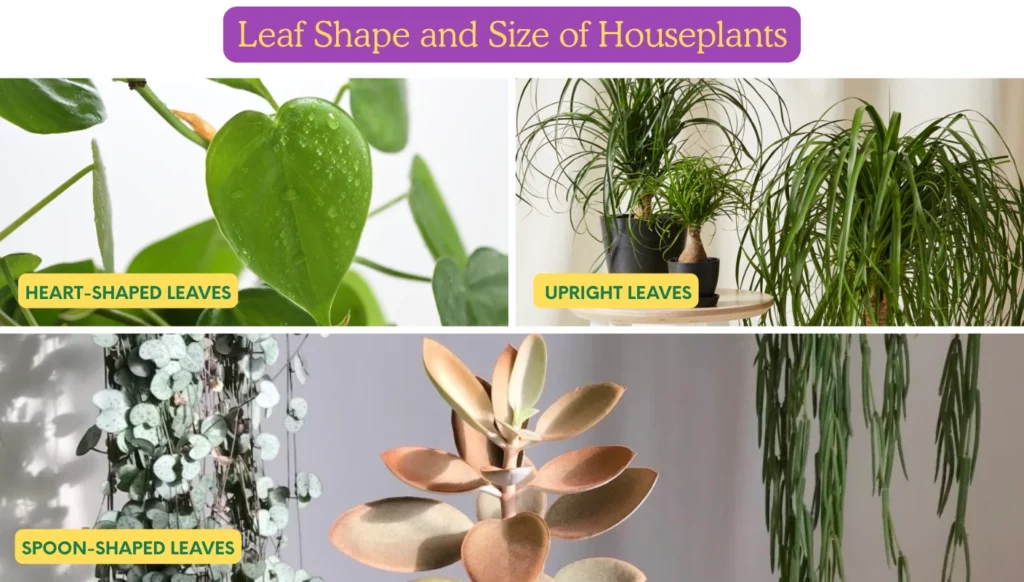
Leaf shape is one of the most immediate and helpful indicators.
- Heart-shaped leaves are a common trait of Philodendron varieties. These plants often have smooth edges and a soft, drooping form.
- Narrow, upright leaves with pointed tips, like those on a Snake Plant (Sansevieria), suggest a succulent adaptation and high drought tolerance.
- Rounded or spoon-shaped leaves, often seen in Peperomia or Chinese Money Plant (Pilea), signal compact growth and low water needs.
Leaf size also matters. Monstera deliciosa, for example, produces large, split leaves, whereas Fittonia has much smaller foliage, making it well-suited for terrariums. When using leaf shape and size for houseplant identification, it’s helpful to view the plant at different maturity stages, as young and mature leaves can differ significantly.
Leaf Texture and Color
Texture and color offer deeper clues, especially when shapes appear similar across species.
- Glossy, thick leaves, as seen on Pothos, ZZ Plant, and Rubber Plant (Ficus elastica), often indicate plants that store moisture and tolerate lower humidity.
- Matte or velvety leaves, such as those on some Calatheas or Philodendrons, suggest a need for more consistent moisture and higher humidity.
Color patterns also matter:
- Solid green leaves are standard across many species.
- Variegated leaves — those with patches, streaks, or edges of white, yellow, or cream are typical in cultivars of Pothos, Snake Plant, and Aglaonema.
- Deep purple undersides, found in plants like Tradescantia or certain Prayer Plants, can also serve as a helpful marker.
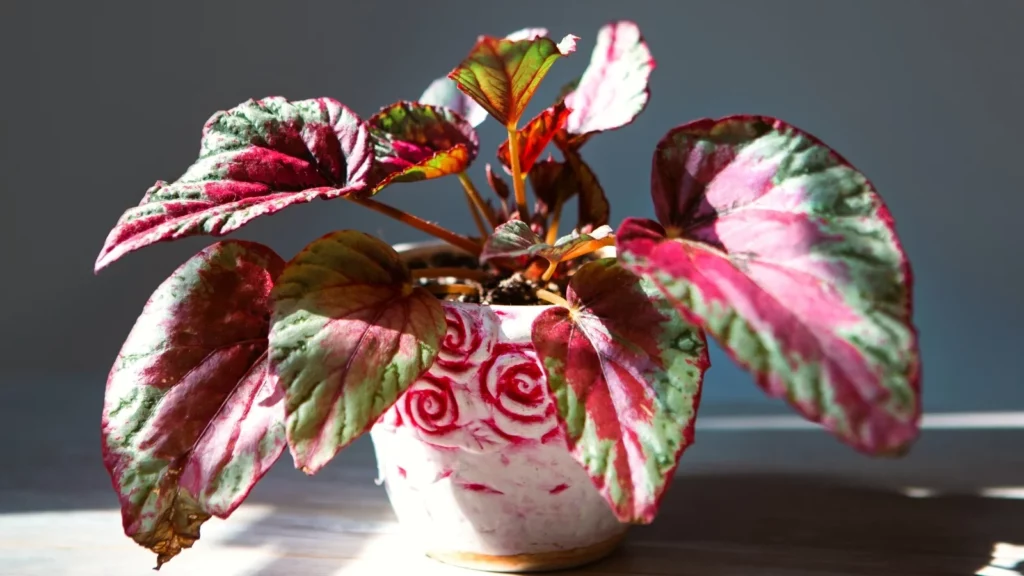
Growth Pattern
- Trailing or climbing plants like Pothos, Monstera, or Philodendron scandens tend to produce long stems and aerial roots. They’re often found spilling over pots or climbing supports.
- Upright growers, such as ZZ Plant or Snake Plant, produce vertical shoots or stalks with little lateral spread.
- Bushy or rosette-forming plants (such as Peperomia, African Violet, or Aloe) stay compact and radiate outward from a central point.
Understanding a plant’s natural growth pattern helps distinguish look-alikes. For example, both Pothos and Philodendron have heart-shaped leaves, but Pothos typically trails more vigorously.
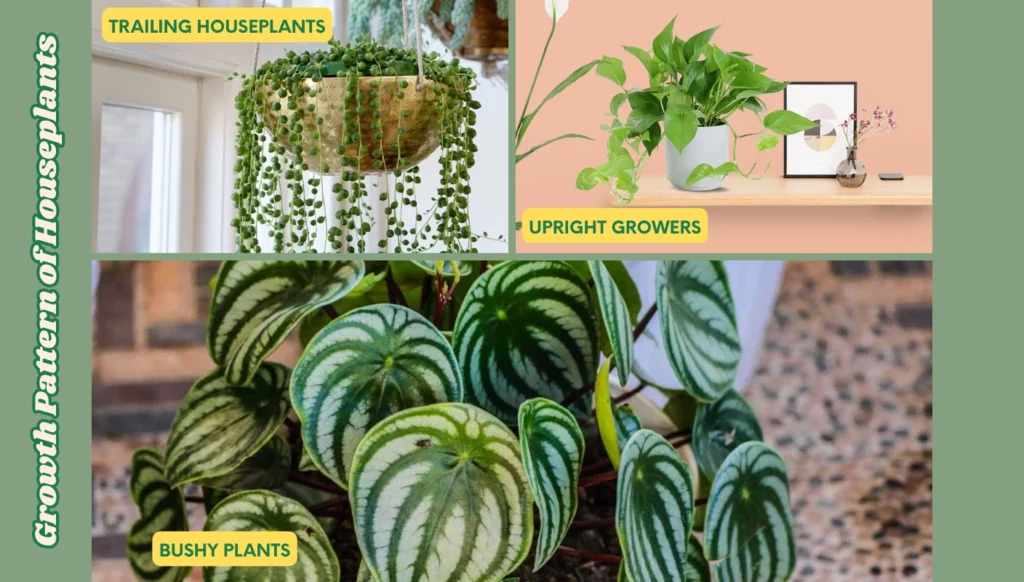
Stems and Roots
- Woody stems are typically found on older specimens or shrubs, such as Ficus or Rubber Plants. These stems become firm and brown with age.
- Succulent stems, which appear thick and moisture-filled, suggest species such as the Jade Plant or certain Euphorbias.
- Vining stems with nodes, where leaves, roots, or offshoots emerge, are typical of Monstera, Philodendron, and Hoya.
- Aerial roots, often visible along stems, absorb moisture from the air and are especially common in tropical climbers like Monstera or Philodendron.
Root visibility also plays a role. Orchids, for instance, often have thick, silvery aerial roots that extend beyond the pot and are critical for nutrient intake.
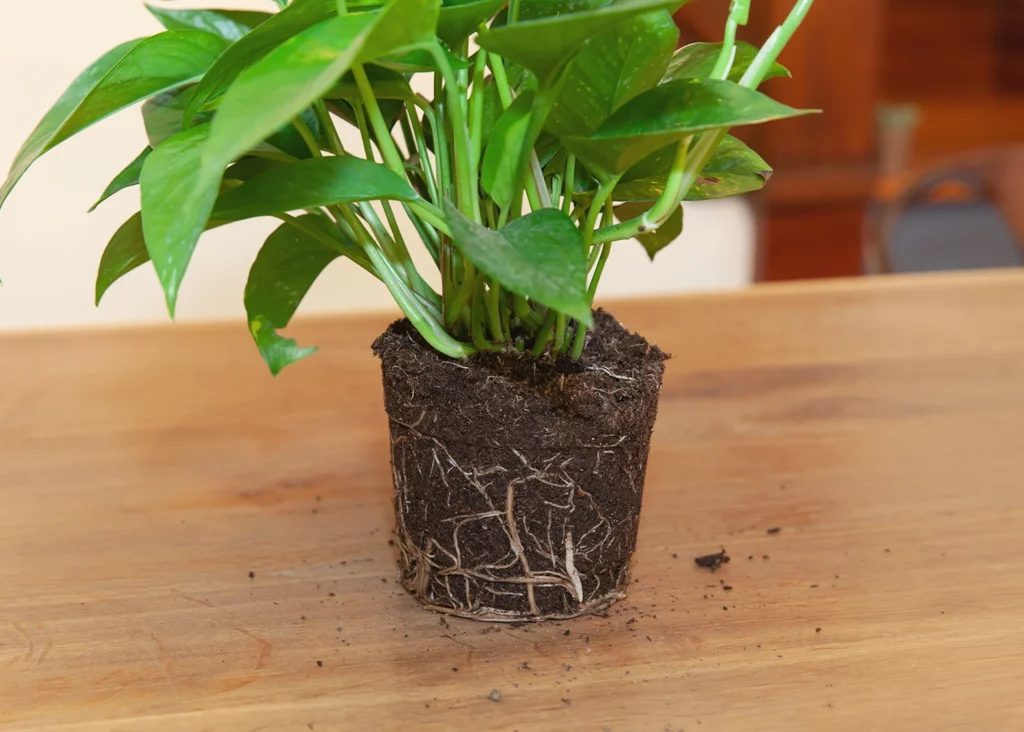
Common Houseplants You Should Recognize
Below are three essential groups to focus on: beginner-friendly staples, commonly misidentified varieties, and toxic vs. pet-safe options.
Beginner-Friendly Favorites
These plants are popular for good reason: they’re low-maintenance, adaptable to different environments, and forgiving if you forget a watering or two.
- Pothos (Epipremnum aureum) – One of the most common vining houseplants. It has heart-shaped, often variegated leaves and can thrive in both low light and bright, indirect light. Its versatility makes it a frequent entry in houseplant identification apps and guides.
- Peace Lily (Spathiphyllum) – Recognized for its dark green foliage and white “flowers” (which are actually modified leaves called spathes). It prefers medium light and consistent moisture.
- Snake Plant (Dracaena trifasciata) – Features upright, sword-like leaves that can be solid green or variegated. Known for its ability to survive in low light and dry indoor air.
- Spider Plant (Chlorophytum comosum) – Easily recognized by its arching green-and-white striped leaves and baby plantlets that grow along long stems. It’s non-toxic, quick to grow, and thrives in indirect light.
Due to their durability and distinctive traits, these species are frequently used as training examples in houseplant identification resources.
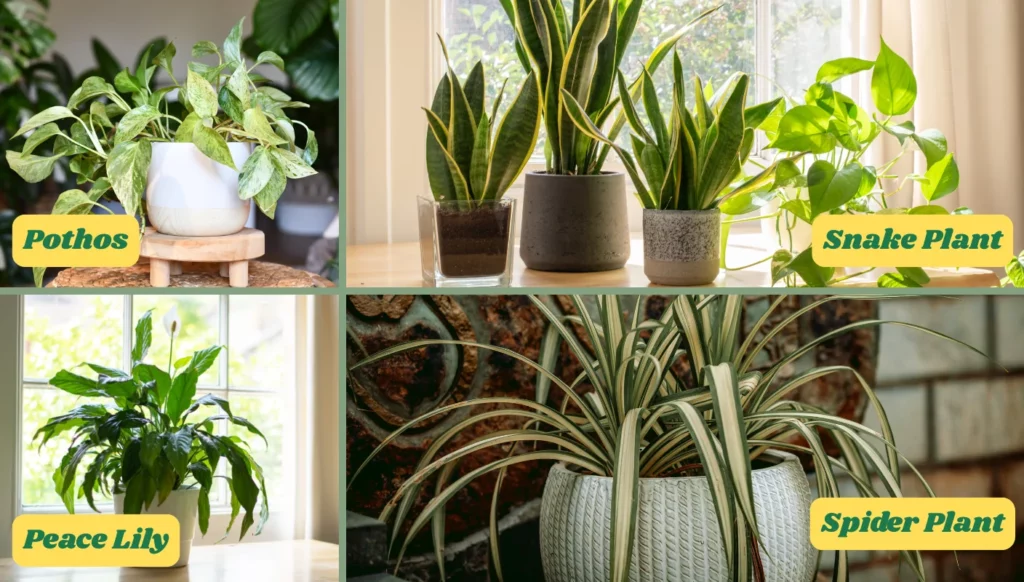
Most Misidentified Houseplants
Even experienced plant owners sometimes confuse similar-looking species. Correct identification is crucial, as these plants often require distinct care routines.
- Aglaonema vs. Dieffenbachia
Both have upright growth habits and patterned foliage, but they differ in subtle ways. Dieffenbachia typically has thicker stems, broader leaves, and a more compact structure.
Aglaonema leaves are often narrower and more pointed. Without close inspection, it’s easy to mistake one for the other, especially in the early stages of growth. Many houseplant identification tools now feature side-by-side comparisons of these two genera to reduce confusion.

- Monstera vs. Philodendron
Young Monstera and certain heartleaf Philodendrons can appear almost identical. However, Monstera deliciosa develops large, split or fenestrated leaves as it matures. Philodendron leaves tend to stay intact and may have a smoother or softer texture.
In terms of growth, Monstera often produces aerial roots and climbs aggressively, while many Philodendrons stay more compact or trail gently. These visual differences are a focus area in advanced houseplant identification tutorials and image databases.
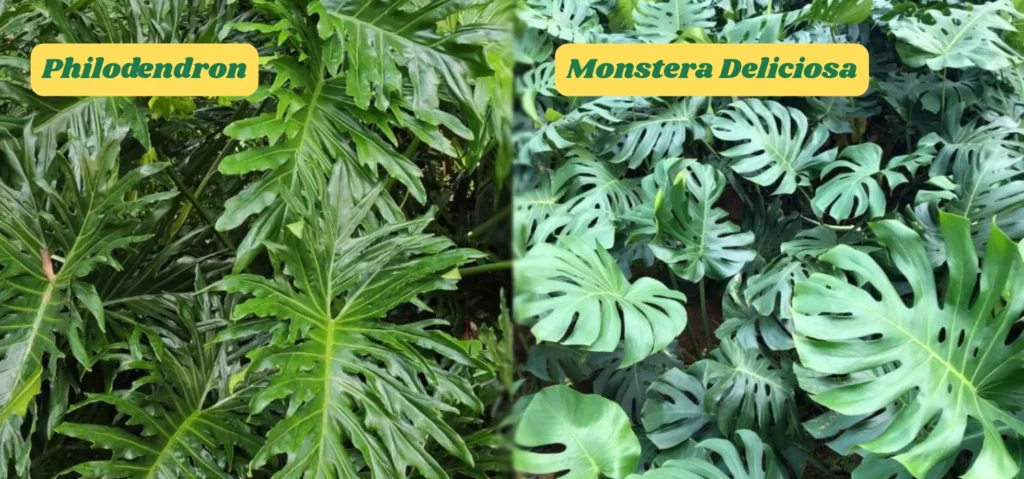
Toxic vs. Pet-Friendly Plants
If you have pets, proper plant identification goes beyond aesthetics. Some beautiful and common plants can pose real health risks to animals if chewed or ingested.
- Toxic to pets:
– Peace Lily contains calcium oxalate crystals that can irritate the mouth and digestive tract of cats and dogs.
– Snake Plant is mildly toxic and can cause nausea or vomiting.
– Dieffenbachia can cause oral swelling and drooling if chewed.
– Philodendron also contains calcium oxalates and can lead to gastrointestinal distress.
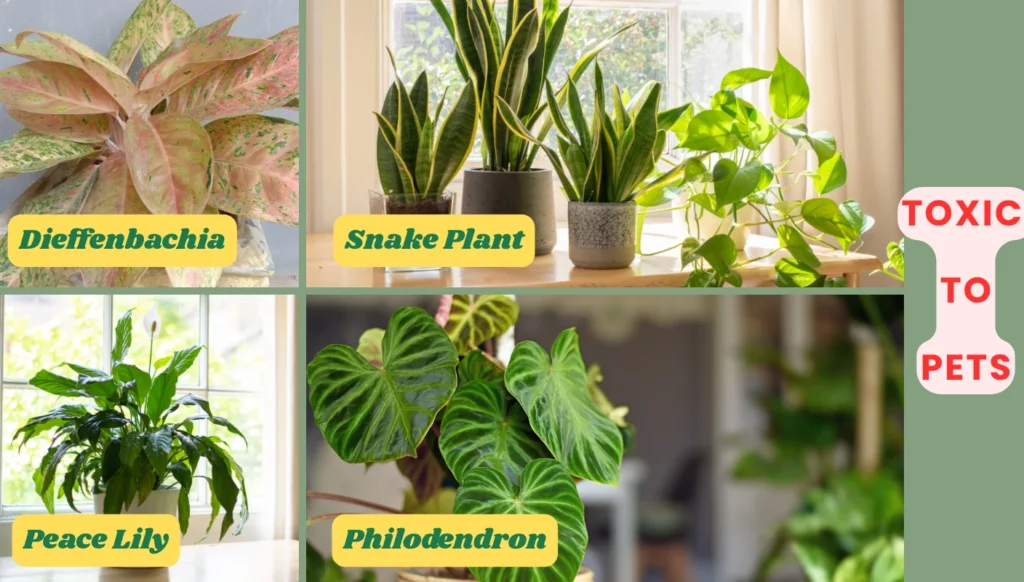
- Pet-safe alternatives:
– Spider Plant is a non-toxic option with fun, arching foliage.
– Calathea offers striking patterns and is safe for curious pets.
– Boston Fern prefers high humidity and indirect light, and is safe for cats and dogs.
– Areca Palm is an elegant, non-toxic palm well-suited for indoor settings.
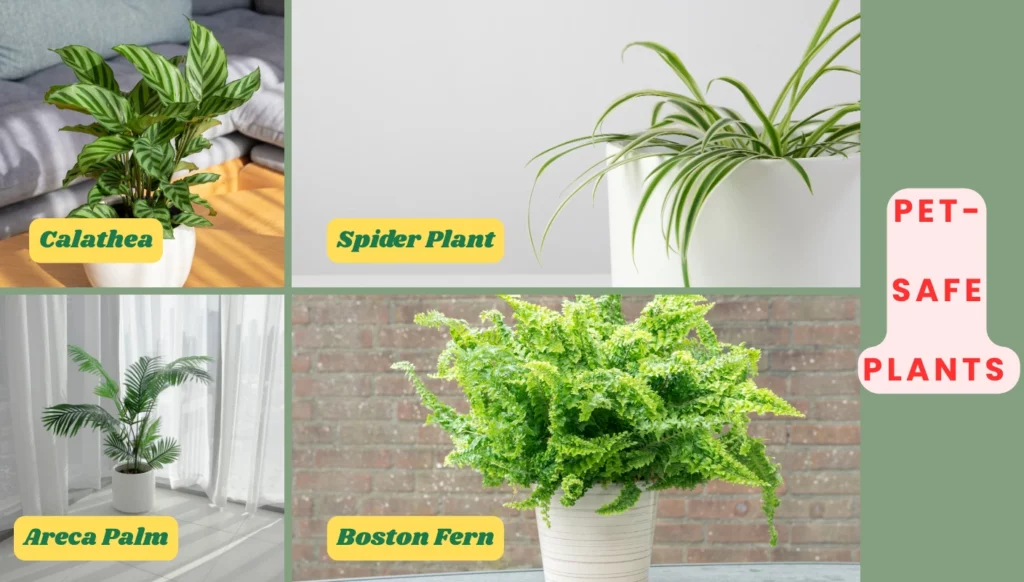
Identifying Indoor Plant Bugs and Damage
Pest problems are a common but often overlooked part of houseplant care. Early detection can prevent long-term damage or plant loss. Below are the key signs to watch for, the pests that may be responsible, and how they typically appear during houseplant identification checks.
| Visible Sign | Possible Pest | Notes for Indoor Plant Bugs Identification |
| 1. Sticky residue on leaves or furniture | Mealybugs, scale insects | Look for white cottony clumps (mealybugs) or brown bumps on stems (scale). The sticky substance is honeydew, a common pest byproduct. |
| 2. Webbing between leaves | Spider mites | Fine webbing near leaf joints is a strong indicator. Also check for tiny red or brown dots crawling on the underside of leaves. |
| 3. Yellowing or pale leaves | Spider mites, fungus gnats | Mites suck sap from leaves, causing discoloration. Fungus gnat larvae can damage roots, reducing nutrient uptake. |
| 4. Leaf holes or chewed edges | Caterpillars (rare indoors), beetles | Usually uncommon, but sometimes appears on plants recently brought in from outdoors. Check leaf undersides. |
| 5. Sudden leaf drop | Scale insects, mealybugs | Severe infestations can stress plants, leading to dropping of healthy-looking leaves. |
| 6. Tiny white flying insects | Fungus gnats | Often confused with fruit flies. These bugs hover near the soil and breed in moist conditions. |
| 7. Wilting despite watering | Root damage from larvae | Root-eating pests (like fungus gnats) may interfere with water absorption, causing wilting even if soil is damp. |
Final Tips for Accurate Houseplant Recognition
1. Check the underside of leaves. Many pests and ID clues are often overlooked (houseplant identification often misses this).
2. Look at how new leaves emerge. It’s a reliable trait across species.
3. Note the root type when repotting. Fibrous, aerial, or tuberous roots can narrow it down fast.
4. Pay attention to leaf symmetry. Monstera splits are asymmetrical; Philodendron’s are not.
5. Use seasonal growth changes as clues. Some houseplants go semi-dormant in winter
Conclusion
In a nutshell, if you want healthy houseplants, houseplant identification is where it starts. Once you identify the species, you can provide it with the right care, spot early signs of pests, and avoid risks, especially in homes with pets. Use tools like the Planteyes app to identify your plants, track their needs, and grow with more confidence.
FAQs
What’s the best free houseplant identification app?
Planteyes, PlantNet, and PictureThis are among the top free apps. Planteyes is particularly well-suited for houseplants due to its comprehensive database, helpful care tips, and timely pest alerts.
Can I identify a plant by a leaf only?
Yes, but accuracy improves if you also check stems, roots, and growth patterns. Apps and visual guides can identify many plants from a clear leaf photo, but comparing multiple traits is best.
How accurate are plant identification apps?
Most modern apps achieve 85–95% accuracy when the photo is well-lit, focused, and shows distinct features. Double-checking results with trusted plant databases or forums is still recommended.
What bugs are common on indoor plants?
Spider mites, mealybugs, scale insects, and fungus gnats are the most common pests. They can be identified by webbing, sticky residue, or leaf damage.


